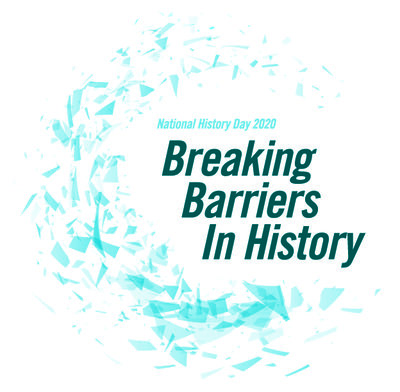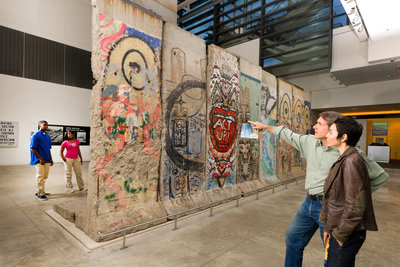Resources for 2020 National History Day Projects
Newseum Education offers rich online and on-site content for student projects related to the NHD 2020 theme of "Breaking Barriers in History."

When thinking about what is a barrier, the first thought that might come to mind is a wall or a fence. However, barriers can be much more than physical structures, whether man-made or natural.. They can be ideological, theoretical, or even dispositional. Political, legal or legislative, social or societal. Barriers can have positive or negative consequences, or they can even serve as markers for historic milestones.
We've compiled a list of examples from our resources to help you brainstorm ideas for your National History Day project. Expand your thinking regarding all the different types of barriers, and good luck with your project!
Students can find plenty of project ideas among our 1,500+ digital resources of historical front pages, artifacts, original newsreels and photographs. These primary sources have explanatory text and are searchable by topic, century, person and more.
(To access many of these resources that are copyright protected, you must have a NewseumED account; registration is free. We do not collect data on students, nor do we spam, sell or share the email addresses.)
A sampling of NewseumED content related to 2020's theme:
Social & Societal
- Jesse Owens: Overcoming Discrimination to Break World Records
- Executive Order 9981: Breaking Down Barriers of Segregation in the Military
- Loving v. Virginia: Interracial Couple Fights Legal Barrier to Marriage
- Executive Order 11478: Breaking Down Barriers of Federal Discrimination
- Brown v. Board of Education: Removing the Barrier of Educational Segregation
- Breaking Barriers for Blacks to Vote: From the 15th Amendment to the Voting Rights Act of 1965
- The Removal of Poll Taxes: Ratification of the 24th Amendment
- Check out our EDCollection (described below) on the civil rights movement to learn more about key figures, such as Martin Luther King Jr., John Lewis, Medgar Evers, A. Phillip Randolph, Ida B. Wells-Barnett, Rosa Parks, W.E.B. Du Bois, James Meredith and Fred Shuttleworth.
- Woman Suffrage Activists Hold First Protest at the White House Fence
- Breaking Barriers by Women Suffragists and their Organizations: From the Seneca Falls Convention to the League of Women Voters
- Sylvia Pankhurst and the Movement for Women's Suffrage in the United Kingdom
- Check out our EDCollection (described below) on the women's suffrage movement to learn about key figures that secured voting rights for women, including Alice Paul, Susan B. Anthony, Elizabeth Cady Stanton and Carrie Chapman Catt.
- Martin Luther and the Protestant Reformation: Breaking Religious Barriers
Political & Governmental
- Nelson Mandela: Breaking the Barrier of Apartheid in South Africa
- Ratification of the U.S. Constitution: The Colonies Overcome the Final Barrier to Statehood as The Pillars of the Republic Are Built
- Mohandas Gandhi: Breaking the Barrier for Indian Independence
- The Fall of Saddam Hussein: Breaking Down Authoritarian Rule
- Franklin Delano Roosevelt: First U.S. President to Serve Three Terms
- Barack Obama: First African American U.S. President
- Thurgood Marshall: First African American U.S. Supreme Court Justice
- First U.S. Congresswoman, First Woman Nominated for U.S. Presidency, First Female Speaker of the House of Representatives
Discovery & Exploration
- The First Solo Transatlantic Trips: Breaking the Barrier of Flight
- First Americans in Space: Pushing the Limits of Our Galaxy
- The First U.S. Transcontinental Railroad: Furthering Westward Expansion
- Major Breakthrough in Treatment for AIDS: Breaking Scientific Barriers

Free Expression (First Amendment issues):
- The Debut of LBGTQ Literature: Rising Up Through the Power of the Pen
- The Pentagon Papers: A Call for Governmental Accountability
- Jacob Coxey's Army: Petitioning Against Income Inequality
- Mary Beth Tinker's Black Armband of Peace: Giving a Voice to Students
- The Skokie March: Removing Barriers to Allow Hateful Assembly
- Citizens United Ruling: Breaking Down Barriers to Corporate Donations to Campaigns
Physical & Natural
- The Berlin Wall: Dividing East from West
- President Kennedy Ends the Naval Blockade: Thawing of Tensions in Cuba
- D-Day: Overcoming Cliffs and Nazi Defenses in Push to Liberate
- The Selma March: Breaking Through the Line of Law Enforcement Officers
EDCollections
- “Making a Change" illustrates how the civil rights movement embraced the freedoms provided under the First Amendment to break through the barriers of inequality and discrimination in society. It contains an interactive timeline on key events and people. Watch a newsreel of President Lyndon B. Johnson signing the Civil Rights Act of 1964, one of the crowning accomplishments of the movement.
- “Women, Their Rights and Nothing Less" reveals how women overcame societal barriers and stereotypes to earn the right to vote in the United States. An interactive timeline details the various strategies women employed to break down the barriers that kept them out of the voting booth.
- "Free Speech Essentials" pairs historical and contemporary case studies to show how the barriers to free expression have enlarged or restricted our freedoms over time. Explore the collection to see how the removal of certain barriers to the freedoms of the First Amendment have been both beneficial and harmful to society.
Students are free to use images of any sources from the Newseum Collection in their National History Day projects as long as they visibly credit “Newseum Collection." If you have any questions, please email [email protected].